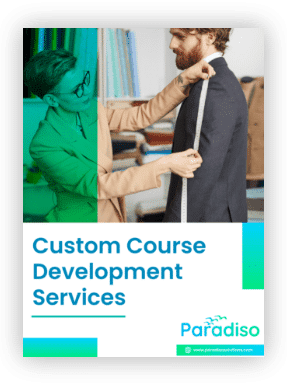Did you know that online training and upskilling have become top priorities for most businesses, with nearly half of L&D specialists expecting their budgets to increase?
How to Create Engaging e-Learning: Effective eLearning Strategies for Professionals

The global eLearning market was valued at $200 billion in 2019, a figure that caught the attention of many. However, this growth is far from over. By 2030, industry analysts project that the global online learning market will reach $840.11 billion, growing at a CAGR of 47.5%
This remarkable expansion of eLearning worldwide necessitates the development of effective strategies to streamline course design and boost efficiency. This highlights the importance of both instructional and post-instructional strategies. While there are plenty of eLearning ideas and opportunities, organizations aiming to ensure the practical application of learning at work must rely on something other than random video recordings or employees’ expenditures. Instead, they need a well-structured eLearning strategy.
What is an eLearning Strategy?
An eLearning strategy is a comprehensive plan designed to guide the development, implementation, and evaluation of online training programs within an organization. It ensures that the eLearning initiatives align with the organization’s goals and effectively meet the learners’ needs.
Detailed Breakdown
- Needs Analysis: This involves identifying the organization’s skills and knowledge gaps. Methods such as surveys, interviews, and performance data analysis gather detailed insights into what learners need to achieve.
- Learning Objectives: These are clear, specific goals that define what learners should be able to do upon completing the training. Objectives should be SMART: Specific, Measurable, Achievable, Relevant, and Time-bound.
- Instructional Design: This phase involves the creation of the learning experience using instructional models such as ADDIE or SAM. It includes developing engaging eLearning content, incorporating multimedia elements, and designing interactive activities. Tools like Cognispark can facilitate the creation of multimedia-rich eLearning modules.
- Technology Selection: Choosing the right platforms and tools, such as Learning Management Systems (LMS) and authoring tools, is crucial for delivering eLearning content effectively. Paradiso LMS, for example, offers a robust solution for managing and providing online training.
- Implementation: This step involves rolling out the eLearning program. It includes setting up the necessary technology, training instructors, and preparing learners. A well-thought-out implementation plan ensures a smooth transition and readiness among all stakeholders.
- Evaluation and Feedback: Continuous assessment is key to the success of an eLearning program. Collecting feedback from learners and analyzing performance data help refine the content and delivery methods, ensuring the training remains effective and relevant.
Why is Engagement Necessary in eLearning?
Engagement in eLearning is critical because it directly influences the effectiveness of the training. Engaged learners are more likely to retain information, apply new knowledge, and achieve the desired learning outcomes. Let’s delve deeper into the different types of engagement in eLearning.
Technical Aspects:
Learning Management Systems (LMS):
AI-powered platforms like Paradiso LMS provide a centralized system for managing, delivering, and tracking eLearning activities. They offer features such as user management, content delivery, assessment tools, and reporting capabilities.
Authoring Tools:
To deliver the content, consider using Cognispark eLearning authoring tools. These tools come with DALL-E-powered media generation and generate interactive and multimedia-rich eLearning content without requiring extensive technical skills. They support various media formats and provide templates for different instructional scenarios.
Analytics and Reporting:
Advanced eLearning strategies incorporate data analytics to track learner progress, engagement levels, and performance outcomes. This data-driven approach not only enhances the effectiveness of your training but also ensures that it remains aligned with your organizational goals and learner needs.

Free Brochure
Paradiso Solutions: Custom Course Development Services Brochure
Get our guide to learn how Paradiso Solutions can help you create personalized eLearning experiences tailored to your organization’s needs.
Engaging eLearning Strategies for Learning professionals
Understanding Your Audience
Personalization enhances engagement by making the content relevant and relatable. Knowing your learners is very important as it directly affects the development of the course outline. Conduct a thorough audience analysis to gather information about their learning preferences, challenges, and goals. The results from your study will help you tailor the content to meet your training’s effectiveness and the learners’ expectations.
Setting Clear Learning Objectives
Learning objectives provide a roadmap for the course. Clearly defined goals help learners understand what they are expected to achieve and how to accomplish it. This clarity motivates learners and keeps them focused on the desired outcomes.
Incorporating Interactivity
Knowledge without application is dusty information. You need your learners to interact with the course. The easiest way is to add assessments. This way, you can make them interact and learn much of the training they need. Interactive quizzes, simulations, and branching scenarios encourage active participation and enhance knowledge retention.
Organizing Content Effectively
A well-structured course is easier to navigate and understand. Use a logical sequence for your modules, provide clear instructions, and ensure a consistent design throughout the course. This reduces cognitive overload and helps learners focus on the content.
Utilizing Microlearning
Microlearning delivers content in short, focused segments that are easy to digest and retain. This approach is highly effective for busy learners who must fit learning into their schedules. Microlearning modules can be accessed on-demand, allowing learners to engage with the content whenever they have a few minutes to spare.
Enhancing Visual Appeal
Visual design plays a crucial role in engaging learners. Use high-quality images, infographics, and videos to enhance the visual appeal of your course. Consistent branding and a professional look contribute to a positive learning experience.
Stimulating Curiosity
Curiosity drives engagement. Use storytelling, real-life scenarios, and thought-provoking questions to pique learners’ interest. Creating a sense of curiosity motivates learners to explore the content and actively participate in the learning process.
Providing Practical Experience
Ensure the content is relevant and applicable to the learners’ roles and responsibilities. Use real-world examples and scenarios to demonstrate the practical application of the knowledge. Providing a meaningful experience helps learners see the value of the training and motivates them to apply what they have learned.
Allowing Self-Paced Exploration
Give learners the freedom to navigate the content at their own pace. Self-paced learning allows learners to revisit challenging sections and skip those they are already familiar with. This flexibility enhances the learning experience and accommodates different learning styles.
Celebrating Achievements
Recognize and celebrate the completion of the course by acknowledging the learners’ achievements. Providing certificates, badges, or other forms of recognition can motivate learners and give them a sense of accomplishment. This not only boosts morale but also encourages continued learning.
Top 5 E-Learning Approaches
Self-Paced Online Courses
Self-paced online courses allow learners to access content at their convenience. These courses are typically delivered through an LMS, which tracks progress and performance. Learners can revisit content as needed, making this approach ideal for busy professionals who must fit learning into their schedules.
Instructor-Led Online Courses
Instructor-led online courses involve real-time interaction with instructors through webinars or virtual classrooms. This approach combines the benefits of online learning with the personalized touch of live instruction. It allows immediate feedback, Q&A sessions, and interactive discussions, enhancing the learning experience.
Blended Learning
Blended learning combines online and face-to-face instruction, offering the benefits of both methods. This approach provides the flexibility of online learning with the hands-on experience of in-person training. Blended learning is particularly effective for complex subjects requiring theoretical knowledge and practical application.
Microlearning
Microlearning delivers content in short, focused segments that are easy to digest and retain. This approach is highly effective for busy learners who must fit learning into their schedules. Microlearning modules can be accessed on-demand, allowing learners to engage with the content whenever they have a few minutes to spare.
Gamification
Gamification uses game elements such as points, badges, and leaderboards to make learning more engaging and fun. This approach taps into learners’ intrinsic motivation, encouraging them to complete tasks and achieve goals. Gamification can significantly enhance engagement, motivation, and retention.
Conclusion
Creating engaging eLearning content requires a strategic approach that considers the needs and preferences of the learners. By implementing effective strategies such as knowing your learners, setting clear objectives, and incorporating interactive elements, you can create a compelling learning experience that motivates and engages your audience. As the eLearning industry grows, staying ahead with innovative and effective strategies will ensure that your training programs are successful and impactful.
Paradiso Solutions leads the eLearning industry with innovative tools and methodologies for creating top-notch content. Our Paradiso LMS, powered by conversational AI, streamlines eLearning management and delivery. Advanced analytics offer deep insights into learner engagement and performance, allowing continuous improvement of your strategy. With our authoring tool, you can quickly create training materials, while our AI-assisted content delivery and a library of over 100,000 courses keep learners engaged.













